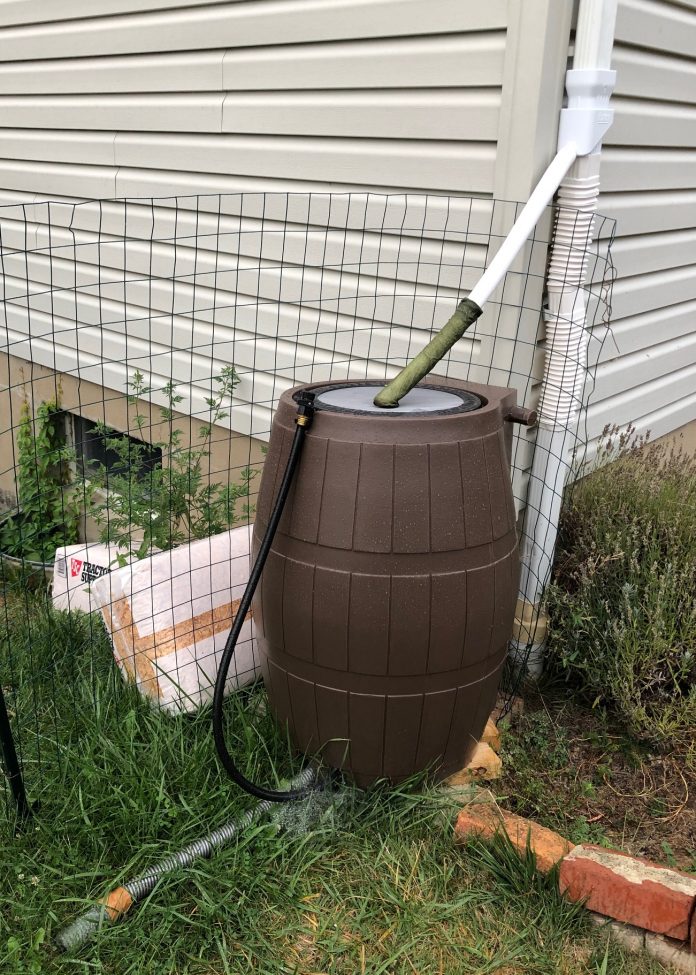
So far in this series I’ve talked mainly about growing the pandemic plants themselves. Today I’m going to branch out a bit into the needed “support” activities.
To grow well, plants need three things – soil, water, and sunshine. I can’t help much with the sunshine, but I will share a few things I’ve been doing to help with the water and soil situation. These activities are low to no-cost, and so are ideal for the “apocalypse garden” situation. Even if it’s late in the growing season, this can give you some things to plan for next year.
Compost
This first thing you can do to help your soil health is to start composting. I’ve written about it before a bit here. Composting is not only good for the soil, but also helps a great deal with the household waste stream.
Even if you only have an apartment balcony “garden”, the soil in your containers will benefit from compost you create from your own kitchen scraps. Compost will also help you “refresh” this season’s potting soil for use again next year, thus saving you money in the long run.
I have done cold composting in a plastic contractor bag in my garage for about three years now. The drawback to cold composting is that you need to chop things pretty small and try to keep seeds out of it as there won’t be enough microbial heat generated to kill them. Shredded junk mail makes a great carbon source to balance out the nitrogen source of the kitchen fruit and veggie scraps and also helps to keep down any smell. (Though I have not found smell to be a huge problem as long as you keep meat/dairy out of your compost and turn the bag regularly to aerate everything). Using that paper also reduces the household waste stream even further.
This year I started an outdoor compost bin mostly for the garden scraps. Having a spot to toss the trimmings that will eventually break down into soil amendment for next year is convenient and free, and doesn’t have to be unsightly. Mine is made of rebar and green mesh, tucked back against a forsythia bush that isn’t easily viewed from the street.
Urine as fertilizer
A second type of composting I’ve been experimenting with uses yet another free resource – urine. Bear with me if that grosses you out. But if you are fine with cow manure and horse manure for fertilizer, you need to know that human urine is actually a “cleaner” option, so it shouldn’t bother you to use this free resource.
Unlike manure, urine is actually sterile upon exit from the body. Unless you have an infection or are on serious chemotherapy drugs or something, urine makes a fine and free nitrogen source for your garden and compost. It has been well – studied in other countries.
I started down this particular path accidentally. I was experimenting with what to use in my “luggable loo” in an emergency to absorb liquid nitrogenous waste, rather than cat litter or other commercial concoctions. I decided to try the shredded junk mail and cereal boxes that I use for my compost as an absorbent material. Every couple uses I’d also add a layer of played-out potting soil from my window garden to the liner bag too.
Storing the bag in my garage when it was full (I live alone, so there’s no one else to object), after a few months with occasionally rolling the bag around to mix, I ended up with a nice broken-down dark compost. It has worked great as an under layer when starting a new planting bed or container – and it was free.
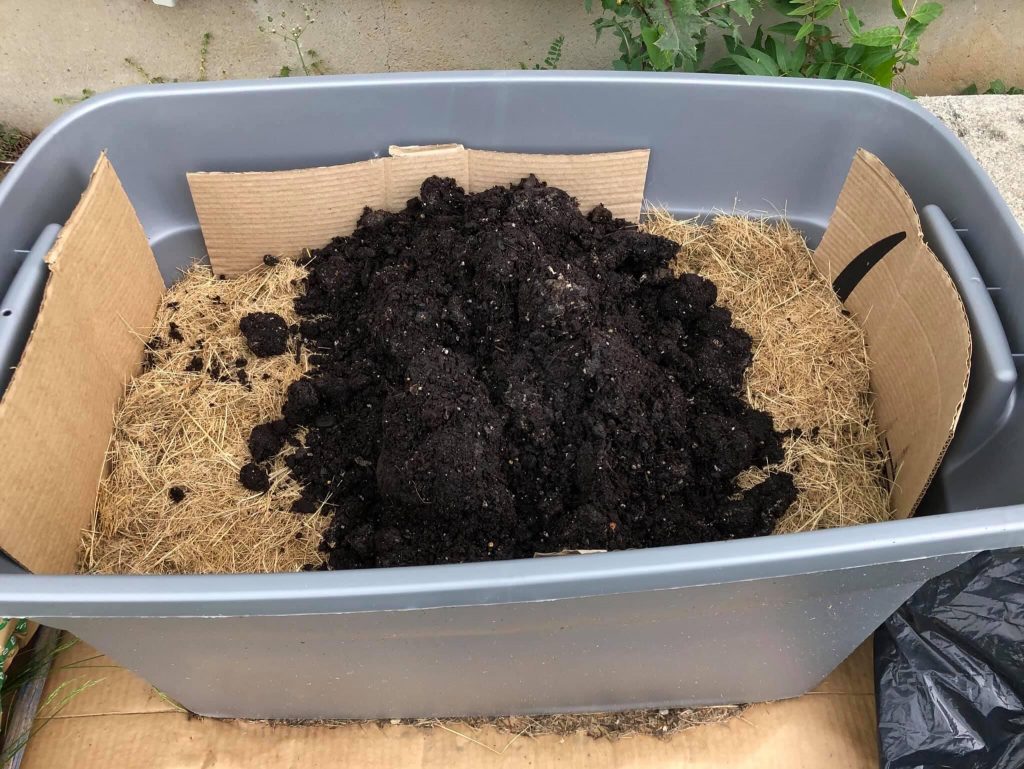
There are other ways to use urine as fertilizer. It can be deposited directly onto the compost heap if you are male and the compost is in a secluded area, or you can deposit it into a dedicated container like a peanut butter jar to then be poured onto the compost later. You can use it diluted as a weekly liquid fertilizer too, but but it should be applied directly onto the soil and not sprayed over foliage or edible portions of food crops.
In a collapse situation there probably aren’t going to be large amounts of chemical fertilizer available. If you don’t have livestock to provide manure for fertilizer, then human urine is an abundant and free source of nitrogen and trace minerals.
Cardboard mulch
Another free soil treatment I have tried came about as a result of the pandemic and my composting efforts. The lockdown stuff resulted in a lot of online ordering, which resulted in a lot of extra corrugated cardboard boxes arriving at my home.
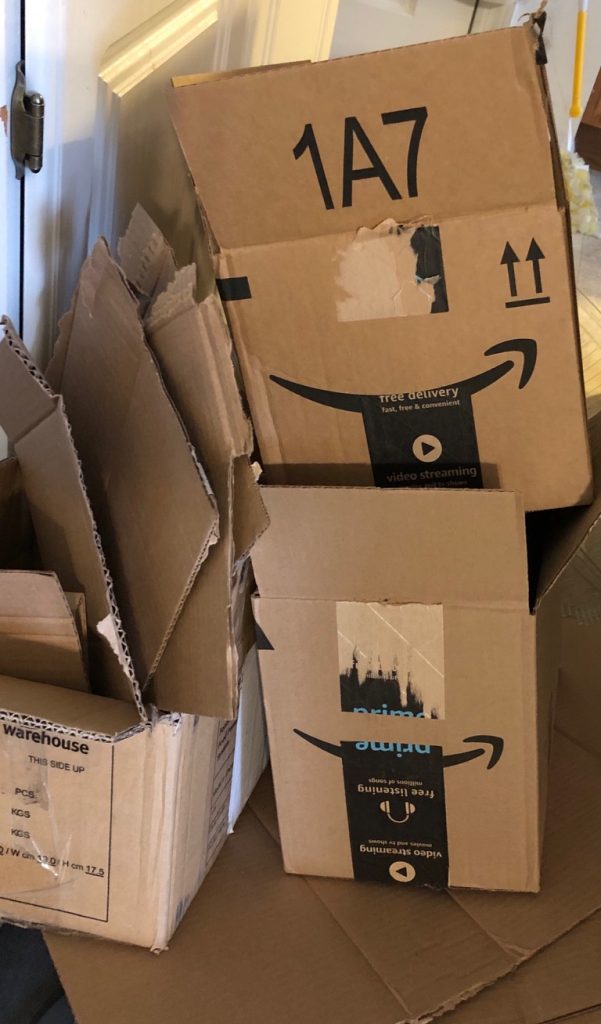
The larger boxes worked well to suppress grass when starting a new planting bed. But what to do with the smaller ones? I decided to try shredding them and using them as mulch in the planting beds. I figured they were brown anyway, so they wouldn’t be as unsightly to the neighbors as my regular multicolored paper compost shredding.

I decided to do a trial in the bed next to the house in the backyard. I first laid down wet newspaper and brown paper which also arrived in those cardboard boxes. That was followed by handfuls of shredded brown boxes, which was followed by a light watering to encourage it all to stick together rather than blow around.
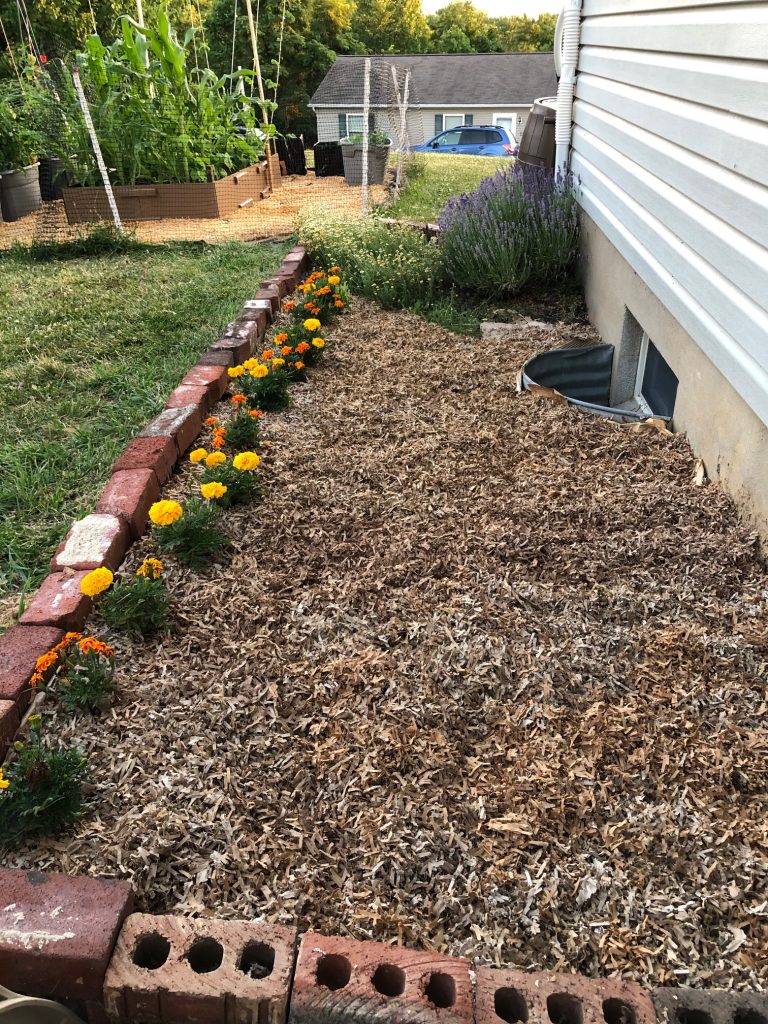
It’s been a couple of months now and I am very pleased with the results. The shredded cardboard and base paper combo are suppressing weeds nicely, while also holding on to moisture and helping keep the soil from drying out too much around the plants. Worms also love to eat cardboard, so this encourages their proliferation in your soil.
It’s really hard to find a downside to this mulching method – maybe it’s that you have to have a fairly heavy-duty shredder to handle the corrugated cardboard. This method not only keeps dozens of boxes out of the landfill, it looks neat and tidy, is completely biodegradable, and best of all – it’s FREE!
I’m calling it a win. Give it a try and see what you think.
Water
After soil, water is the next indispensable ingredient for a garden. While true that you can just use the hose in normal circumstances, in a prolonged dry spell it can be hard on your well or your water bill with heavy usage. In a collapse situation you may not have city water service at all.
With my pandemic garden this year I issued myself a personal challenge. I wanted to use the hose as little as possible to see how it went. This turned into a quite an education in the value and use of water.
Gray water
The first step I took was to try to use only “gray water” or other water that I would normally let run down the drain. I didn’t go whole hog and re-route the washing machine or anything, I started small.
The first step was sitting a bucket under the shower while the water warmed up. That gave me 2-3 gallons daily, which I dumped into a lidded Rubbermaid tub outside the back door. The lid helped to deter mosquitos and the idly curious pet or wildlife. This was completely clean, potable water which would have otherwise run down the drain. I was previously wasting it, so I considered it “free” garden water even though I was technically paying for it.
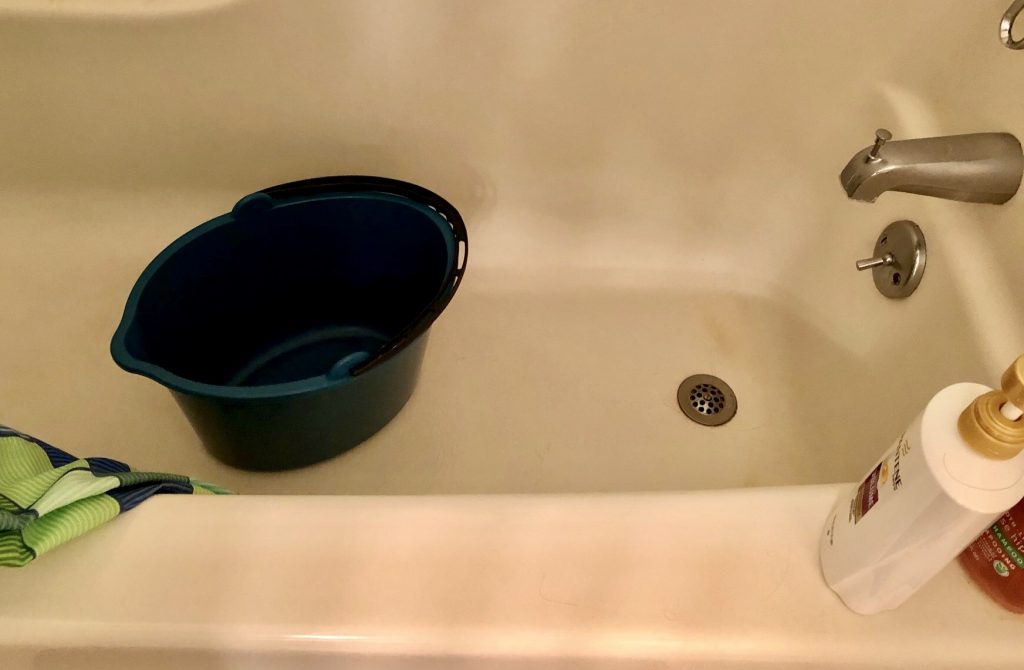
Then I started putting a small “Easter bucket” by the kitchen sink into which I poured water that I washed vegetables in and water that I wasted letting the spigot water get hot enough or cold enough. That gave me another couple gallons a day to dump into the outside storage container.
Later I started adding water in which I had blanched vegetables for freezing. Some people also do pasta water, but mine just seemed a little too slimy/starchy, and I didn’t want my outside container to start smelling like a garbage can. I also added the water from my basement dehumidifier to the mix. I used up that stored water pretty promptly, so it didn’t have much chance to sit around and get stagnant and smelly, and the residual chlorine from the “clean” shower water helped keep the bacterial load down.
Eventually as my garden expanded, I needed more water than my gray water collection could provide. Which brings me to the next category.
Rain water collection
When my gray water production became insufficient I started looking into rainwater collection. Although my DIY skills are improving, I really didn’t want to tackle a DIY rain barrel system. It would have saved me some money, but some things are worth the investment to me and this was one of them.
I first ordered the downspout attachment to get the rainwater from my gutters to the storage barrel.
Then I ordered a rainbarrel from Amazon. I can’t find the link anymore for the actual company, but it was made in Canada not China (which was important to me at the time).
I admit that I had a bit of drama while setting up the downspout attachment. My house has downspouts that empty directly into the french drains- they don’t just dump out onto the lawn.
Following the directions on the box, I started sawing through the downspout with a hacksaw in order to insert my redirect attachment. Somehow I failed to notice that the bottom portion of the downspout wasn’t supported by anything. As I finished the last cut, the downspout section dropped down into the French drain below ground about a foot beyond my reach! *insert f-bombs*
I tried reaching it with barbecue tongs, but no luck. So I rushed off to the home improvement store while thunder rumbled in the distance, still muttering profanity under my breath.
Not wanting to purchase an entire 20-foot length of downspout, I bought three two-foot sections instead and some flexible elbows to jury-rig my solution. Then I rushed back home just ahead of the thunderstorm. I finished the job as the first big drops of rain were starting to fall. Whew!
That first storm filled the 54-gallon barrel and lasted me for an entire week’s worth of watering. My roof isn’t that big and the downspout was only draining one section. It only took that first storm to convince me of the utility of a rain barrel. I had no idea I could channel that much water that easily.
However, if things filled up with one storm then I needed to decide what to do about overflow. I decided against setting up a second barrel in series. I didn’t want to over-invest in my first season. The barrel did come with a flattened “hose” of sorts that was supposed to handle overflow, but it didn’t work very well.
I ended up jury-rigging a better solution for the overflow using an old vacuum cleaner hose ( I am not a a hoarder…), zip ties, and duct tape. It has worked well for me so far. I added knee high pantyhose to the ends of the hoses as an insect filter, too. Standing water can be a mosquito breeding ground and nobody wants LaCrosse Encephalitis, West Nile, etc., trust me.
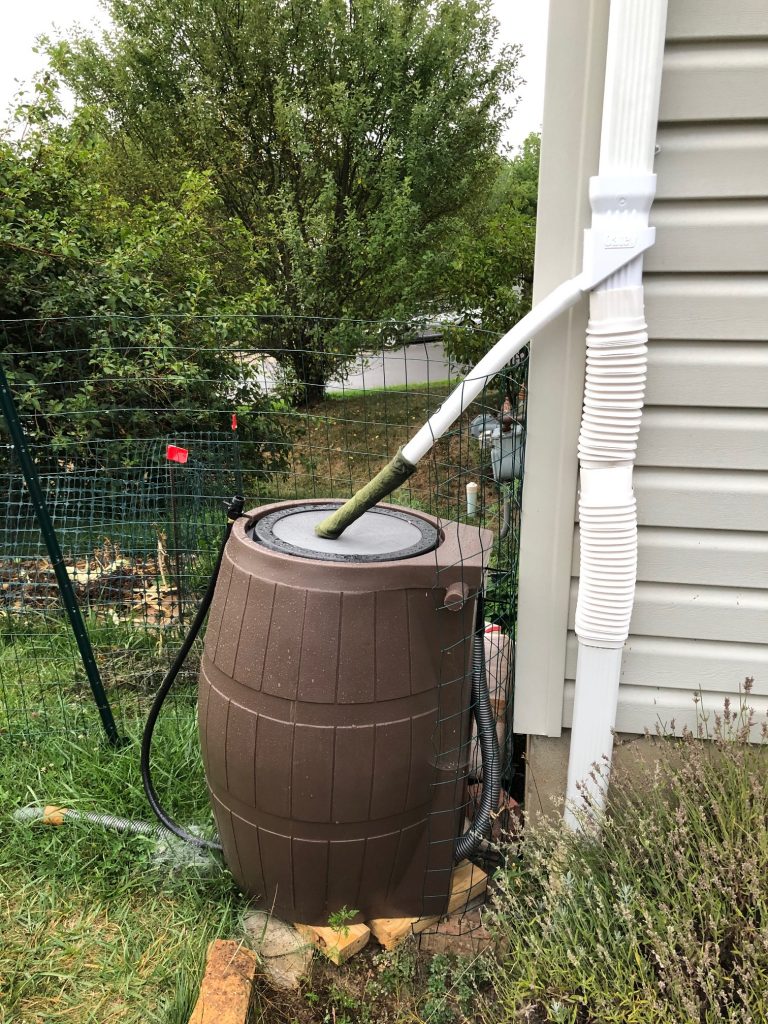
As of this writing I’ve saved myself roughly 400 gallons of city water and the growing season isn’t over yet. This was accomplished with comparatively little effort, so it was definitely a good investment. Yes there was bucket-carrying involved but I’m not getting much exercise otherwise, so it was all good for me. Aren’t gym kettle bells really just glorified buckets anyway?
Another advantage to having a rain barrel is that it provides an alternate source of water in an emergency. Because god-knows-what is on my roof getting washed off (bird poop, mold in the gutters, etc) I wouldn’t want to drink the water straight. But boiling and a Life Straw filter would probably fix that in an emergency. That water would also be useable to flush toilets (as long as the drains work) and for hand-washing if boiled. You could even boil the water with your SilverFire Survivor Stove.
This whole exercise has really made me appreciate water much more than I used to. It’s easy to take such a precious resource for granted when you can just open a tap whenever you want. But when you have to save your water carefully and hand-carry it in buckets you realize how much you’re using, what it weighs, and what an achievement it is to have clean water piped right to every household. It also makes you realize what a shame it is to flush perfectly drinkable water down the toilet. But that’s the way things work until society comes up with a better plan.
All of that convenience isn’t likely to be there during an apocalypse, so planning ahead for garden and household water is a really good idea that you probably shouldn’t put off any longer. I’m glad I’ve started to address it.
I know that all of these measures I’ve talked about sound like a lot of work – and it was. But it was accomplished in small baby steps. This year’s reality is that I’ve had a lot of time on my hands and gardening has been a productive way to channel that energy and time. Honestly, all of this garden related activity has kept me sane and focused during a really difficult season. So, gardening is therapy I don’t have to pay someone for AND I get to eat the results. Win-Win.
The pandemic gardening isn’t over yet, so stay tuned for an update piece on how things went, what grew, what didn’t, and plans for next year.



